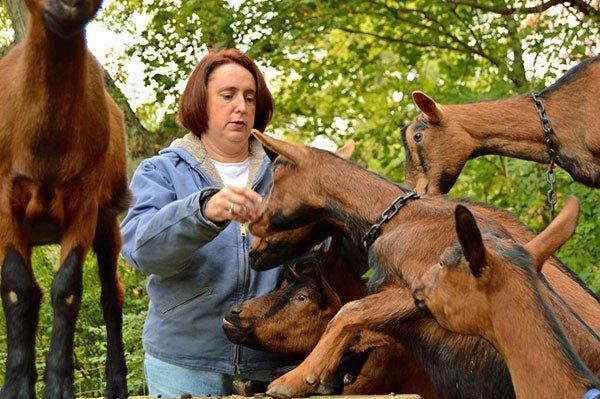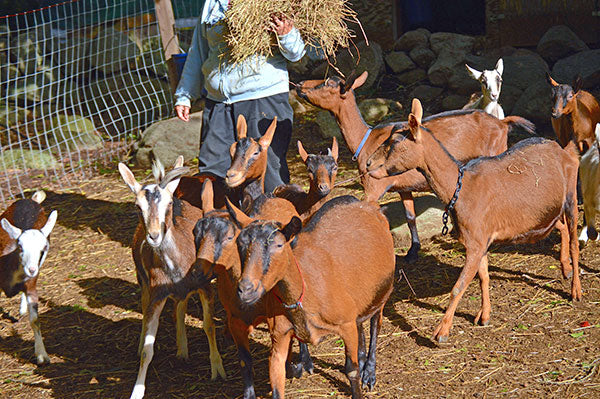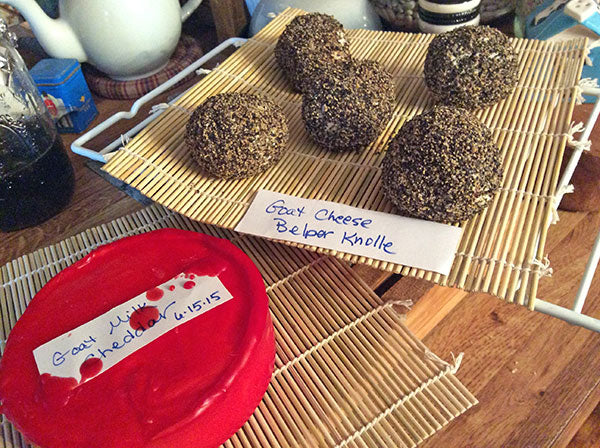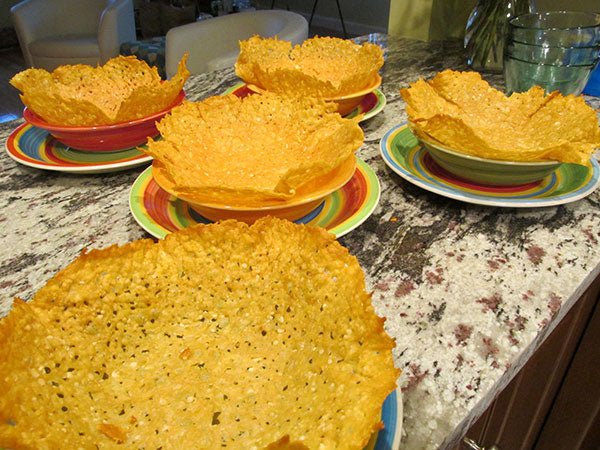Why do they call it a “hobby farm” when it’s so much hard work? A hobby is an activity you do at your leisure and raising goats is not that! Fortunately, Barbara and her husband have 4 sons to help with their hobby farm while they work full time, raise and milk a small herd of goats, tend a vegetable garden, gather honey from their bee hives and make cheese. Are you impressed? We are!
Barbara Crudale wrote us a few months ago to share her excitement about making crottin successfully on her first try. We asked for more information:
How did you begin making cheese?
Initially we were considering dairy cows about 6 years ago, but decided that goats are much easier (smaller, less feed). We now have a small herd of mainly Oberhaslis. This summer I milked 4 and plan on breeding 4 again this fall.
Milking quickly led to more than we could use in baking and coffee, so cheese was the next step. I make lots of chèvre in the summer, flavored with herbs from our garden. I also made goat cheddar this summer and Jim Wallace’s goat cheese with ash, featured in the May/June issue of Dairy Goat Journal. Goat milk soap and lotions are also popular gifts from our farm.
The American Cheese Society‘s annual conference was in Rhode Island this past August. My husband and I were introduced to crottin at the Cheese Festival and this has become our latest favorite. I volunteered to cut and wrap cheeses at the ACS, so I was able to attend the Festival of Cheese on Saturday night.
What kind of farm do you have?
Crudale Farm is located in rural RI, about 15 minutes from the closest town. Currently we raise RI Red and Bardrock chickens, as well as the small goat herd of 6 does and 5 kids. We started with Oberhasli goats, but I have also bred Alpine into the herd. I am curious to see the milk from the Alpine/Oberhasli doe next summer.
I plan on breeding 4 does again this fall. My aim is to keep about 6-8 breeding does, breeding 4 each year. We do not have a limit where we live – the limit is self-imposed based on the time to milk in the morning and the cost to feed and keep the herd healthy. With 4 milking does, I get up at 5:00 during the school year, and it takes about 45 minutes to milk. I have to leave my house by 6:45 to get to work, so I do not think I could milk another doe and still get to work on time!
We also started with two bee hives this year and are looking forward to honey next fall. Occasionally in the past we have raised turkeys and beef.
My husband and sons (ages 14 to 21) maintain a huge vegetable garden. We freeze or can green beans, zucchini relish, tomato sauce and pickles each year.
Our 4 sons are all very helpful; Alfred and I complete morning chores, and the boys help out in the afternoon. They also help me transport the does during breeding season for their rendezvous overnights to other farms with bucks…the does come back smelling like the buck and the boys have named our mini van the “goat mobile.” By the time breeding season is over, the van gets a good airing out!
And I forgot to mention our collie, Lancelot!
We would love to make a living from our farm, but we are happy being a “hobby farm.” We can and freeze many of the vegetables from our garden and hope to be able to gather honey next fall from the bees. I also make bread (almost nightly, with four sons!) for lunches and often make dough on the weekend for pizzas. My husband is a college professor and I am a school counselor at our local high school. We do sell our eggs when we have extra and give holiday gifts of goat milk soaps and lotions. The cheese is also consumed by friends and family.
Approximately twice a year, we have a Cheese Night with two other couples; we have 5 types of cheeses, with charcuterie, fruits, jams, olives, honey, pate and assorted breads and wine. We have been doing this for about 5 years now. I usually try to contribute at least one cheese to Cheese Night; we even take notes and rate all the cheeses as we taste them! Not a great picture, but you can see all the great foods we have on Cheese Night.
What kind of cheeses are you hoping to make in the future?
I want to try Swiss, possibly with goat milk.
Where are you aging your cheeses?
Cheeses are aged in a wine cooler in my cellar. I had tried a small dorm size refrigerator, but it was too cold. Right now there are a few crottins and goat cheddars aging.
Have you thought about selling your cheese?
We have debated this for awhile, as well as selling the soap and goat milk lotions I make. We have decided to keep milking the 4 does, as it is just enough for us to handle. If we moved to selling cheese, we would need to build a dairy parlor with a separate septic system, increase the number of goats, and deal with additional marketing, packaging, delivery, etc. So I guess the main deterrent would be time and finances. The secondary deterrent are the rules about cheese and raw milk products (all cheese needs to be aged 6 months to be sold, unless the milk is pasteurized.) So, we have decided to be happy making cheese and other goat milk products and sharing with our friends and family.
Pictures of Barbara’s Crottin
Barbara has been using Jim Wallace’s recipe to make Crottin de Chavignol ever since she and her husband tried it at the 2015 American Cheese Society Convention in Providence, Rhode Island. Barbara’s son, Thomas, is an amazing photographer (click here), so he documented her process of making this cheese (your proof that it is easy to make at home!).






































































































































































